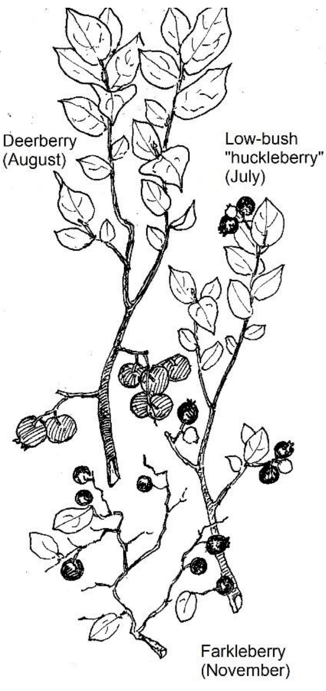Before there was Saturday Night Live there were the Farkleberry Follies. Founded in 1967, this performance convened every other year was a time when a collection of Arkansas journalists conducted skits to spoof state politics in general, and Governor Orval Faubus in particular. In a recent editorial, Rex Nelson reported that the main objective of the show was to “skewer the inflated egos of the political class.” The show got its name from an editorial by local cartoonist George Fisher who poked fun at the governor over a folksy meeting where Faubus had lectured a brush-clearing highway crew about the native species of shrubs in our region. One of the most obscure of these was the tree blueberry or farkleberry (Vaccinium arboretum) with its amusing name.
There is a direct Ozark Society connection here because the family of current Ozark Society President, David Peterson, received one of the prized farkleberry awards bestowed from the hands of Dale Bumpers some 30 years ago on behalf of a folk music group founded by Fisher in Pulaski County. The shrub itself is especially common in the Ozarks and Ouachitas where it is found growing on the edges of cliffs and around rock ledges. We frequently encounter farkleberry thickets on our outdoor adventures along the Buffalo River Trail and in other popular or scenic areas. The tall shrubs often grow in impossibly contorted forms that are fun to observe. But there’s more to the farkleberry story than that.

The shrub is especially relevant for me because it was a big part of the chain of events that caused me to select Arkansas for my retirement home. As an environmental scientist I had the opportunity to work for weeks at a time with colleagues at USEPA’s Kerr Lab in Ada, Oklahoma. With time on my hands during weekends, I was able to explore the far western end of the Ouachita Mountains. There I was charmed by what I took for extensive stands of high-bush blueberry. That shrub is a prolific fruit-bearing bush in my native New England, and the original source of many cultivated blueberry varieties.
These blueberry shrubs grew even bigger where I saw them in eastern Oklahoma, and I had visions of bumper crops of wild fruit here in future summers. That observation was part of the ultimate decision to settle in Arkansas where I had access to an academic community and hiking opportunities in the oak-dominated forests that reminded me of my native Connecticut.
After spending time in the Ozarks, I would be profoundly disappointed by farkleberry fruit. Even with its nominal resemblance to eastern blueberry, this shrub was clearly different in so many ways. Farkleberry grows to almost tree status, has leathery and semi-evergreen leaves, and tiny, shiny black fruits that mature in October and are dry, seedy and practically tasteless. Perhaps that’s why the birds leave them on the bushes through much of the winter.
There are two other very different blueberry species on the bluffs above the Buffalo River, and they can have some tasty fruit on the rare occasions when conditions allow. This is one of those rare occasions. The most common of these is a low trailing plant known as “huckleberry” (which is actually the name of another fruiting shrub entirely) forming a knee-high ground cover that spreads rampantly by underground “runners” on well-drained, cherty soils (Vaccinium pallidum).
This year the wet spring and sunlight from openings in the forest canopy provided by wind and ice storms in previous years have allowed these shrubs to produce a crop of small, bluish-black berries that have the expected sweet blueberry taste.
The other native blueberry species known as deerberry does not spread so readily underground and forms compact bushes up to three feet tall (Vaccinium stamineum). This little shrub is unlike other blueberries in having attractive flowers that grow as clusters of white dangling bells you can often see where it blooms with pink azalea on rock ledges (see my illustration in Ozark Forest Forensics). This year is the first that I have seen where deerberry is producing fruit in some abundance. In the last week of July or early August, the shrubs had clusters of relatively large berries, maybe four times the size of the low-bush huckleberries, and a deep reddish purple in color where I found them along old logging roads in the Madison County Wildlife Management Area.
The abundance of these three Vaccinium species in the Ozarks shows why blueberry does so well as a crop in our area. Even if the fruit crop produced by the wild blueberries cannot match the flavor and abundance of the crop variety, the farkleberry provides interest for outdoor enthusiasts from both the fun inherent in the name itself and the improbably contorted shape that our “tree blueberry” can take where found ensconced among scenic rock ledges such as at our iconic Hawksbill Crag or adjacent to the Glory Hole.
